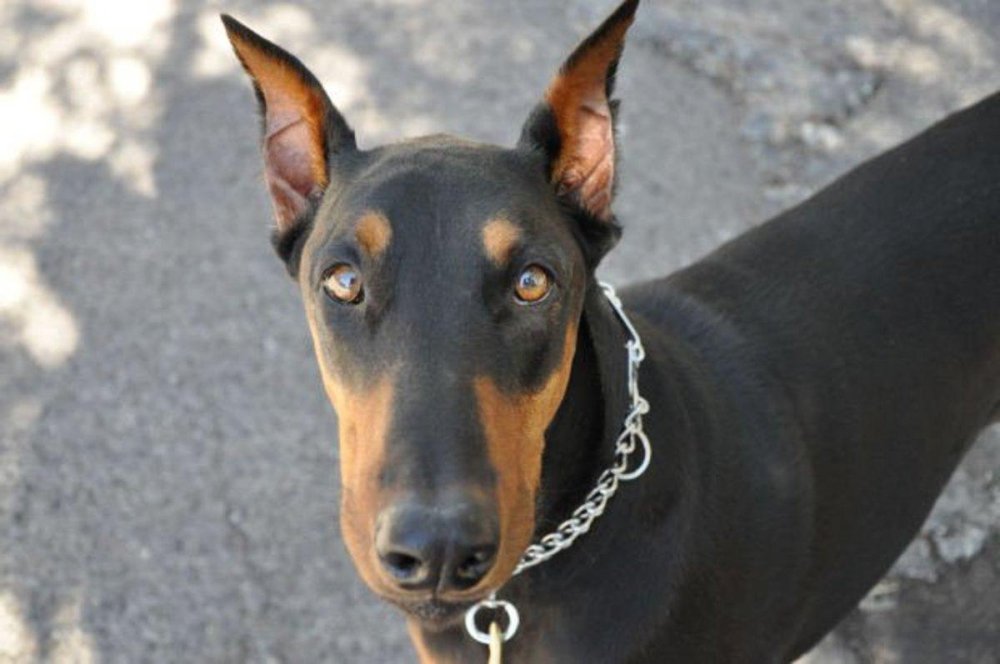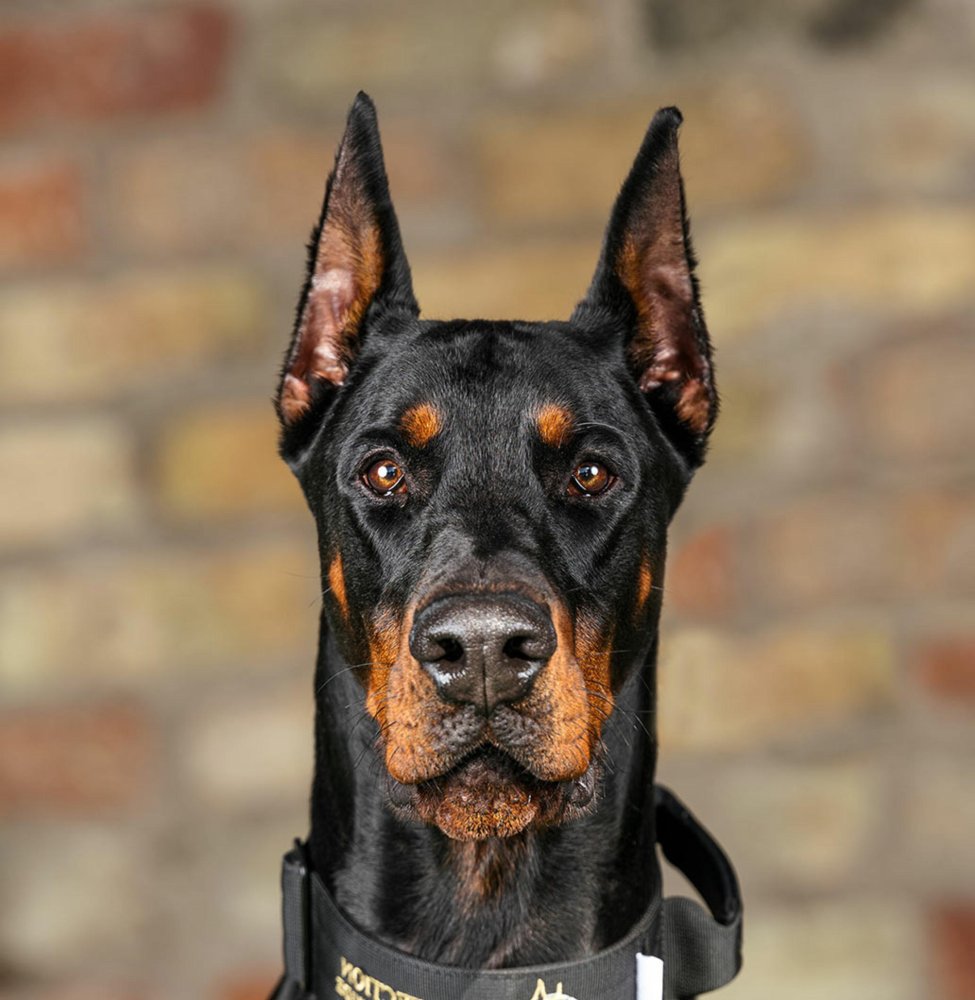- Breed Category: Working Group
- Country of Origin: Germany
- Average Height: Males 68-72 cm, Females 63-68 cm
- Average Weight: Males 40-45 kg, Females 32-35 kg
- Average Life Span: 10-13 years
- Grooming Requirements: Low, occasional brushing
- Exercise Requirements: High, needs daily exercise
- Coat Type: Short and smooth
- Coat Color Variations: Black, blue, red, fawn
- Shedding Level: Moderate
- Ear Type: Naturally floppy, often cropped
- Tail Type: Long, often docked
- Temperament: Loyal, alert, intelligent
- Intelligence Level: Very high
- Barking Tendency: Moderate
- Compatibility with Children: Good with proper training
- Compatibility with Other Pets: Varies, needs socialisation
- Training Ease: Highly trainable
- Common Health Issues: Hip dysplasia, heart conditions
- Dietary Needs: High-quality, balanced diet
- Energy Level: Very high
- Drooling Tendency: Low
- Sensitivity to Weather: Sensitive to cold
- Overall Maintenance Level: Moderate
- Original Purpose: Guard and protection dog
- Year of Recognition by Kennel Clubs: 1908
- Famous Breed Representatives: Apollo from “Magnum, P.I.”
- Apartment Friendly: Yes, with sufficient exercise
- Best Suited For: Active families, experienced owners
- Cost of Ownership: Moderate to high
- Unique Traits: Elegant, athletic build
- Cultural Significance: Popular in media and security
- Popularity Rank: Top 20 in many countries
Think all dogs are just cuddly companions? The Dobermann might surprise you. Known for their sleek, muscular build and keen intelligence, Dobermanns are more than just a pretty face. Originally bred in Germany in the late 19th century, these dogs were designed to be both loyal protectors and affectionate family members. Their history is as rich as their character, with a lineage that includes breeds like the Rottweiler and Greyhound, contributing to their agility and strength.
This article aims to delve into the fascinating world of the Dobermann. We’ll explore their unique characteristics, trace their historical roots, and offer insights into their care. Whether you’re considering adding one to your family or just curious, there’s plenty to learn about this remarkable breed.
History and Origin

Early Development of the Breed
The Dobermann’s story begins in the late 1800s in Germany, thanks to a man named Karl Friedrich Louis Dobermann. He was a tax collector who needed a dog that could protect him during his rounds. By mixing breeds like the Rottweiler, Greyhound, and Weimaraner, he crafted a dog that was both fierce and loyal. This blend of breeds gave the Dobermann its signature traits: speed, strength, and intelligence.
Role in Protection and Companionship
From the start, Dobermanns were more than just guard dogs. They were bred to be companions, too. Their protective nature made them ideal for police and military work, but their affectionate side meant they fit well into family life. They’re known for forming strong bonds with their owners, making them both vigilant protectors and loving friends.
Key Historical Figures
Karl Dobermann wasn’t alone in shaping this breed. Otto Goeller, another key figure, refined the breed further, enhancing its temperament and physical traits. His work ensured the Dobermann became the well-rounded dog we know today, balancing power with grace and loyalty with affection.
Physical Characteristics

Appearance
Dobermanns are known for their striking appearance. They typically stand between 61 to 71 centimetres tall and weigh around 30 to 40 kilograms. Their coat is short, sleek, and comes in a variety of colours, including black, blue, red, and fawn, often with rust-coloured markings above the eyes, on the muzzle, chest, and legs. These distinctive markings add to their regal look, making them easily recognisable.
Unique Physical Traits
One of the most notable features of the Dobermann is its athletic build. They have a lean, muscular body that speaks to their agility and strength. Their wedge-shaped head and alert, intelligent eyes give them an air of nobility. The Dobermann’s tail is usually docked, and their ears may be cropped, though this practice is less common today. Their overall physique is a testament to their heritage as both protectors and companions, combining elegance with power.
Temperament and Behaviour

Typical Personality Traits
Dobermanns are known for their loyalty and intelligence. They’re quick learners, which makes training them a rewarding experience. Their energy levels are high, so they thrive in active households where they can get plenty of exercise. This breed is often described as alert and fearless, yet they have a gentle side that makes them affectionate companions.
Suitability as a Family Pet and Working Dog
These dogs are versatile, excelling as both family pets and working dogs. Their protective instincts make them excellent watchdogs, while their affectionate nature ensures they fit well into family life. They’re happiest when they have a job to do, whether it’s guarding the home or participating in dog sports.
Interaction with Children and Other Animals
Dobermanns generally get along well with children, especially when raised with them. They’re protective yet gentle, making them great playmates. However, early socialisation is key to ensuring they interact well with other animals. With proper training, they can coexist peacefully with other pets, though supervision is always recommended.
Training and Exercise Needs
Importance of Early Training and Socialisation
Getting a Dobermann off to a good start with early training and socialisation is crucial. These dogs are naturally intelligent and eager to learn, but they need guidance to channel their energy positively. Early exposure to different environments, people, and other animals helps them grow into well-rounded adults. This foundation is key to preventing behavioural issues and ensuring they become confident companions.
Recommended Training Techniques
When it comes to training, positive reinforcement is the way to go. Dobermanns respond well to rewards like treats, praise, and playtime. Consistency is important, so keep training sessions regular and engaging. Incorporating obedience training and mental stimulation activities can help keep their sharp minds occupied. Remember, patience and persistence are your best tools.
Daily Exercise Requirements and Activities They Enjoy
Dobermanns are high-energy dogs that need plenty of exercise to stay happy and healthy. Aim for at least an hour of physical activity each day. They love activities like running, hiking, and playing fetch. Engaging in dog sports such as agility or obedience trials can also be a great way to meet their exercise needs while strengthening your bond.
Health and Lifespan
Common Health Issues
Dobermanns are generally healthy, but like all breeds, they’re prone to certain health conditions. Some common issues include hip dysplasia, heart problems like dilated cardiomyopathy, and von Willebrand’s disease, a blood clotting disorder. Regular vet check-ups can help catch these issues early.
Average Lifespan and Tips for Keeping Them Healthy
On average, Dobermanns live between 10 to 13 years. To keep them healthy, ensure they get plenty of exercise and maintain a balanced diet. Regular mental stimulation is also important, as it keeps their sharp minds engaged. A happy Dobermann is one that feels both physically and mentally fulfilled.
Preventative Care Recommendations
- Schedule regular veterinary visits for health screenings and vaccinations.
- Maintain a healthy weight through a balanced diet and regular exercise.
- Brush their teeth regularly to prevent dental issues.
- Keep their coat clean and check for any skin issues.
- Provide heartworm prevention and flea control as recommended by your vet.
Grooming and Maintenance

Coat Care and Grooming Routines
Dobermanns have a short, sleek coat that’s relatively low-maintenance, but regular grooming is still important. A weekly brush with a rubber grooming mitt or a soft bristle brush will help keep their coat shiny and remove loose hairs. This routine not only keeps them looking their best but also helps distribute natural oils, promoting healthy skin.
Shedding and Seasonal Grooming Tips
While Dobermanns are not heavy shedders, they do experience some seasonal shedding, particularly in spring and autumn. During these times, you might want to increase brushing to a couple of times a week to manage the extra hair. Bathing them every few months or as needed will also help keep their coat clean and minimise odour. Always use a dog-specific shampoo to avoid skin irritation.
Diet and Nutrition

Nutritional Needs for Optimal Health
Feeding a Dobermann the right diet is crucial for their health and vitality. These dogs need a balanced diet rich in proteins, healthy fats, and essential vitamins and minerals. High-quality commercial dog food that lists meat as the first ingredient is often a good choice. Look for options that are specifically formulated for large, active breeds to ensure they get the nutrients they need.
Foods to Include and Avoid
Include lean meats, fish, and vegetables in their diet to provide a variety of nutrients. Foods rich in omega-3 fatty acids, like fish oil, can support their skin and coat health. Avoid foods with artificial additives, excessive fillers, and high-fat content, as these can lead to obesity and other health issues. Always steer clear of toxic foods like chocolate, grapes, and onions.
Feeding Schedules and Portion Recommendations
Establishing a consistent feeding schedule helps maintain their energy levels and digestive health. Typically, adult Dobermanns do well with two meals a day. Puppies may require more frequent feeding. Portion sizes depend on their age, weight, and activity level, so it’s best to consult with your vet for tailored advice. Remember, overfeeding can lead to weight gain, so monitor their body condition regularly.
Fun Facts and Trivia

Interesting Tidbits About the Breed
Did you know that Dobermanns have a unique feature called a “thumbprint”? It’s a small, dark patch of fur on the top of their head, often seen in black and tan Dobermanns. This little mark is considered a sign of good breeding. Another fun fact is that Dobermanns are one of the few breeds specifically created for protection, yet they have a surprisingly gentle side, making them excellent therapy dogs.
Famous Dobermanns in Media or History
Dobermanns have made their mark in both history and pop culture. One of the most famous Dobermanns was “Kaiser,” a war hero who served with the U.S. Marine Corps during World War II. In the world of entertainment, Dobermanns have appeared in movies like “The Doberman Gang,” where they played clever bank-robbing dogs. Their striking appearance and intelligence make them a favourite choice for roles requiring a commanding presence.
Final Thoughts
The Dobermann is a remarkable blend of elegance and strength. Known for their loyalty and intelligence, they excel as both protectors and companions. While they require commitment in training and exercise, the rewards of owning a Dobermann are immense, offering both security and affection. Embrace the journey of raising a Dobermann, and you’ll find a devoted friend and guardian. Consider adding this noble breed to your family for a lifetime of companionship and adventure.
